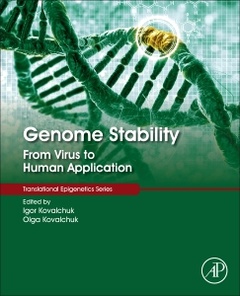Genome Stability From Virus to Human Application
Coordonnateurs : Kovalchuk Igor, Kovalchuk Olga

Every species has to preserve the integrity of its genome to ensure faithful passage of genetic information to the progeny. At the same time, there are times during the life of the organism and population in general when a fine balance in genome stability and diversification has to be made to benefit the survival of the species. Genome Stability teaches the reader how various species maintain this fine balance in genome stability and genome diversification in response to their environments.
Genome Stability covers a wide range of topics, including the genome stability of DNA/RNA viruses, prokaryotes, single cell eukaryotes, lower multicellular eukaryotes and mammals. Topics also include major DNA repair mechanisms, the role of chromatin in genome stability, human diseases associated with genome instability as well as changes in genome stability in response to aging. Finally, Genome Stability covers how epigenetic factors contribute to genome stability and how the species pass the memory of the encounters to the progeny, thus influencing the genome of the progeny in an indirect manner. This volume is an essential resource for geneticists, epigeneticists, and molecular biologists who are looking to gain a deeper understanding of this rapidly-expanding field, and can also be of great use to advanced students who are looking to gain additional expertise in genome stability.
1. Genome stability – an evolutionary perspective Igor Kovalchuk
I. Genome Instability of Viruses
2. Genetic Instability of RNA Viruses John N. Barr and Rachel Fearns 3. Genome instability in DNA viruses Rafael Sanjuán, Marianoel Pereira-Gómez, Jennifer Risso
II. Genome instability in Bacteria and Archaea
4. Genome instability in bacteria and archaea: Strategies for maintaining genome stability Jan-Erik Messling and Ashley B. Williams
5. Genome instability in bacteria: causes and consequences Ashley B. Williams
6. CRISPR - bacteria immune system Andrey Golubov
III. Genome Stability of Unicellular Eukaryotes
7. Programmed DNA rearrangement in ciliates Franziska Jönsson
8. Homologous Recombination and Non-homologous End-joining repair in yeast Rebecca E. Jones and Timothy C. Humphrey
IV. Genome stability in multicellular eukaryotes
9. Meiotic and Mitotic Recombination: First in Flies Julie Korda Holsclaw, Talia Hatkevich and Jeff Sekelsky
10. Genome stability in Drosophila – mismatch repair and genome stability Tomoe Negishi
11. Genome stability in Caenorhabditis elegans Matthias Rieckher, Amanda Franqueira C. Lopes and Björn Schumacher
12. Genetic Engineering of Plants using Zn-fingers, TALENs and CRISPRs Andriy Bilichak and Francois Eudes
13. Plant Genome Stability – General Mechanisms Andriy Bilichak
V. Genome stability in mammals
14. Cell cycle control and DNA damage signalling in mammals Valenti Gomez and Alexander Hergovich
15. The role of p53/p21/p16 in DNA damage signalling and DNA repair Yavuz Kulaberoglu, Ramazan Gundogdu, and Alexander Hergovich
16. Roles of RAD18 in DNA Replication and Post-Replication Repair (PRR) Cyrus Vaziri, Satoshi Tateishi, Liz Mutter-Rottmayer and Yanzhe Gao
17. Base Excision Repair and Nucleotide Excision Repair Tadahide Izumi and Isabel Mellon
18. DNA Mismatch Repair in Mammals Mingzhang Yang and Peggy Hsieh
19. Repair of double strand breaks by non-homologous end joining; its components and their function Patryk Moskwa
20. Double-Strand Break Repair: Homologous Recombination in Mammalian Cells Camille Gelot, Tangui Le-Guen, Sandrine Ragu and Bernard S. Lopez
21. Telomere maintenance and genome stability Wilnelly Hernandez-Sanchez, Mengyuan Xu and Derek J. Taylor
22. The relationship between checkpoint adaptation and mitotic catastrophe in genomic changes in cancer cells Lucy H. Swift and Roy M. Golsteyn
23. Chromatin, nuclear organization and genome stability in mammals Lora Boteva, Nick Gilbert
24. Role of DNA methylation in genome stability Dan Zhou and Keith D. Robertson
25. Non-coding RNAs in genome integrity Igor Kovalchuk
VI. Human diseases associated with genome instability 26. Human diseases associated with genome instability Bruno César Feltes, Joice de Faria Poloni, Kendi Nishino Miyamoto and Diego Bonatto
27. Cancer and genomic instability Wei Wei, Yabin Cheng and Bo Wang
28. Chromatin Modifications in DNA Repair and Cancer Margaret Renaud-Young, Karl Riabowol and Jennifer Cobb
29. Genomic Instability and Aging – Causes and Consequences Corinne Sidler
30. Nucleolar contributions to DNA damage response and genomic (in)stability in the nervous system Michal Hetman
VII. Effect of environment on genome stability
31. Diet and nutrition Lynnette R. Ferguson
32. Chemical mutagenesis
33. Environmental sources of ionizing radiation and their health consequences Aaron A. Goodarzi, Alexander Anikin, Dustin D. Pearson
Section VIII. Bystander and transgenerational effects – epigenetic perspective
34. Epigenetics of transgenerational genome instability in mammals
35. Genomic Instability and the Spectrum of Response to Low Radiation Doses Carmel Mothersill and Colin Seymour
36. Transgenerational genome instability in plants Igor Kovalchuk
37. Methods for the detection of DNA damage Denis V. Firsanov, Ljudmila V. Solovjeva, Vyacheslav M. Mikhailov, Maria P. Svetlova
38. Conserved and divergent features of DNA repair. Future perspectives in genome instability research Igor Kovalchuk
He has substantial expertise in plant stress tolerance and plant transgenesis.
Dr. Olga Kovalchuk is the Principle Investigator of the Human Epigenetics laboratory at the University of Lethbridge. Her lab studies the role of epigenetic dysregulation in carcinogenesis, epigenetic regulation of the cancer treatment responses, radiation epigenetics and the role of epigenetic changes in genome stability and carcinogenesis, radiation-induced oncogenic signaling, and radiation-induced DNA damage, repair, and recombination.
- Includes a collection of chapters on genome stability research from various kingdoms, including topics such as epigenetics and transgenerational effects
- Provides the first comprehensive coverage of the differences in the mechanisms utilized by different organisms to maintain genomic stability
- Contains applications of genome instability and its effect on human diseases
- Explains how various species maintain the fine balance in genome stability and genome diversification in response to their environments
Date de parution : 09-2016
Ouvrage de 712 p.
21.4x27.6 cm



